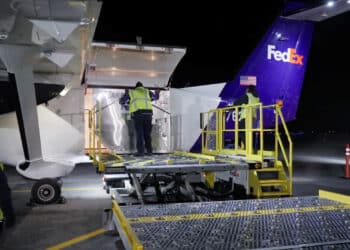A very mixed quarter for UPS

The dramatic drops in net income and operating profit were the result of a combination of two one-time charges totaling $692 million, and the impact of increased spending to avoid the service problems seen in 4Q13 when exploding e-commerce demand overwhelmed express companies capabilities.
Regarding the one-time charges, UPS said that discount rates used to calculate company-sponsored pension and postretirement liabilities at year-end decreased significantly in 2014, resulting in a “non-cash, mark-to-market, after-tax charge of $670 million.” The other $22 million charge related to “a previously announced transfer of certain healthcare liabilities.” Absent the impact of these two charges, net income for the quarter was down 1.9% y-o-y to $1.15 billion, and operating profit was down 2.9% to $1.85 billion.
Commenting on the slight declines in adjusted income and operating profit, CEO David Abney summed the quarter up rather neatly: “UPS customers were delighted with the high quality service we delivered during the holiday season. However, the financial results were below our expectations.”
The chart above shows the company’s financial and operational results for both the fourth quarter and the full year. What is immediately striking, for both the quarter and the year, is that while average daily package volumes were solidly up for every product except Next Day Air, per-package revenue was down for every product except Next Day Air.
UPS said the yield decline in its US Domestic segment was the result of lower fuel surcharges and changes in product mix offsetting increases in base rates. In the International Package segment the reported yield decline was the result of the same lower fuel surcharges and changes in product mix, as well as “stronger intra-regional shipment growth.” UPS pointed out that International Domestic yield actually increased 0.8% when adjusted for currency effects.
The Supply Chain & Freight segment reported solid operational performance in the fourth quarter, with revenue up 7.4% y-o-y to $2.47 billion and adjusted operating profit up 4.7% to $179 million, as gains in Distribution and UPS Freight outweighed declines in the Forwarding unit. However, the segment was hit hard by the one-time charges, and, on a reported basis, suffered a $25 million operating loss.
Returning to the above-mentioned impact of the holiday shopping season, UPS said that operating expense in the fourth quarter increased more than $200 million, “primarily due to higher-than-anticipated peak-related costs.” These included decreased productivity (presumably from the more-than 100,000 temporary employees hired for the peak season), higher contract carrier rates, as well as overtime and training hours.
For the full year, UPS reported adjusted net income up 1.2% to $4.39 billion, as revenues rose 5.0% to $58.23 billion. Adjusted operating profit for the year was up 0.8% to $7.13 billion.
Looking ahead, UPS CFO Kurt Kuehn said that in 2015 the company “expects growth across all business units. E-commerce growth, operations technology implementation, emerging market expansion and industry specific solutions will provide momentum for UPS.” He added that UPS anticipated full-year 2015 earnings per share to be up 6%-to-12% over 2014 adjusted results.




